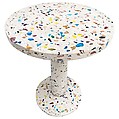Kyoto Table
Designer Shiro Kuramata Japanese
Designer Memphis Milano Italian
Manufacturer Ishimaru Co. Ltd. Japanese
Not on view
Born in Tokyo in 1934, Kuramata studied at the city’s polytechnic high school and Kuwasawa Design School. He revolutionized design in postwar Japan by reconsidering the relationship between form and function, adhering to Minimalist ideas but embracing Surrealism as well. During the 1970s and 1980s, Kuramata began to use new technologies and industrial materials. He was inspired by Ettore Sottsass and joined his design collective Memphis at its founding in 1981. The Kyoto Table is an example of his innovative use of concrete and glass to create a minimalist form with surface interest. It is a clever play on Sottsass’s own use of terrazzo, but rendered light and almost immaterial by substituting rainbow-colored glass inclusions in place of heavy, dark stones. Kuramata called the material Star Piece, which he claimed represented "the debris of memory." He employed it as a surface material in numerous interior design projects and as the basis for a graphic pattern rendered in other materials, making it somewhat of a signature motif.
Due to rights restrictions, this image cannot be enlarged, viewed at full screen, or downloaded.

